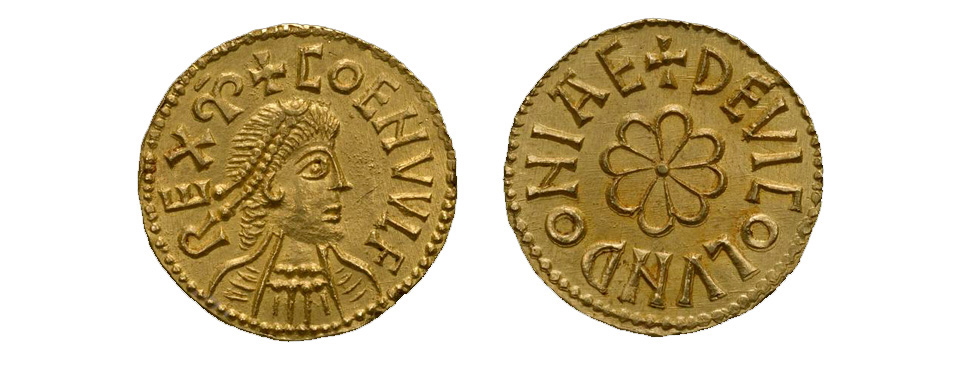The early Saxon settlers and the town of Lundenwic

This gold ‘mancus’ coin is from the reign of King Coenwulf of Mercia and Kent (796-821) stating DE VICO LVNDONIAE (from the trading place of London) when the Saxon settlement was to the west of the old walled city. London was one of several towns minting coins during that period. © Trustees of the British Museum
The Roman city of Londinium went into a long, slow decline from the 3rd century AD and was eventually abandoned. The new Saxon settlers had no need for a walled city. In time they created a new town of Lundenwic outside of the city walls.
London was founded by the Romans in around 43AD and became a flourishing town in the following century, the capital of the Roman province of Britannia. At around that same time Roman civilisation reached its zenith but went into a long decline from the 2nd century. When Rome came under attack from the Visigoths in the early 5th century the Roman army was withdrawn from Britannia in order to defend the imperial capital, never to return. Britain was from then no longer part of the empire of which it had been a part for three and a half centuries. By then London was only a shadow of the city it had been at its peak in the 2nd and 3rd centuries. As trade routes changed, Winchester became more significant, London’s population dwindled, and earth was laid over derelict buildings so that the land could be used for farming.
London possibly continued to survive as a shadow of its former self for the time being but it was no longer the capital of a unified country and much of the manufacturing and trade of the previous 300 years came to an end. Former markets in the Roman empire no longer existed and London was no longer on a through-route to anywhere people wanted to travel. There is evidence of a fall in water levels in the Thames during the latter Roman period and it is possible that during the next few centuries the river at London may not have been tidal, making it difficult to reach from the sea by boat. Most of the old buildings had long gone, the bridge had collapsed and the port no longer in use. If goods could not be sold they were no longer manufactured and the skills of the London craftsmen died out. If money was not being earned buildings could not be maintained to their previous standards. Coins were no longer minted and money no longer circulated. The people of London could no longer afford their former lifestyle and were probably reduced to a basic level of existence of a semi-rural nature.
In the mid-5th century the Romano-English leader Vortigern enlisted the help of sea-faring Saxons, Angles and Jutes from northern Germany to prevent attacks from Picts from the north of Britain. However, the British fought amongst themselves and some of the Germanic tribes, who were no doubt left unpaid, rebelled. After various battles over a 40-year period the country was divided into a network of minor kingdoms and alliances of people of varying ancestry. Generally, the south-east of the country remained populated by Anglo-Saxons while the Romano-English migrated westwards to Wales and the South-West.
During the latter 5th and 6th centuries there were a growing number of Saxon settlements around the south east of Britain but there is little information about London. What is certain is that the old Roman town was not home to Saxon settlers in the early centuries after they arrived in Britain. Around the country there is surviving evidence of their settlements in the form of cemeteries, in which they buried their dead together with jewellery, weapons and other possessions, but no such graves from the period exist around London prior to the 7th century.
The early Saxon arrivals were farming people living in isolated farmsteads and had little use for the old Roman cities. They largely settled around London rather than in it. Discoveries of burial grounds show that during the 5th and 6th centuries a number of Saxon hamlets were established around the London region at Greenwich, Hanwell, Mitcham, Northolt, Croydon and Orpington. A number of other districts around the modern central London have names that are probably of Saxon origin, such as Kensington, Paddington, Islington, Lambeth, Stepney and anywhere ending in ‘ham’, the Saxon word for settlement, such as Fulham. The name Hampstead, mentioned as far back as 959, comes from the Saxon meaning ‘farm-site’. Saxon huts have been excavated at Hammersmith and Harmondsworth.
Fishing was an important source of food along the banks of the Thames and the Saxons built fish traps. The most numerous catches were of eels, pike and roach. Longer-distance fishing in the Thames estuary yielded cod, haddock, herring, bass, whiting, flounder and plaice and various shellfish such as oysters.
During the 7th and 8th centuries Britain evolved into several kingdoms, each battling with its neighbours for supremacy. Central England, from the rivers Mersey and Humber down to the Thames, became the kingdom of Mercia, with London in its far south-eastern corner. The south-west was Wessex, the kingdom of the West Saxons; and Essex that of the East Saxons. For a time Kent was also a separate kingdom. Each kingdom was in turn divided into smaller regions. That to the south of the Thames was the southern area – Surrey – and on the opposite bank the Middle Saxons, or Middlesex, neither of which were kingdoms. London, as much as it existed at all, became a border town, controlled by whichever power dominated, at different times being within the kingdoms of Kent, Essex, Mercia or Wessex.


